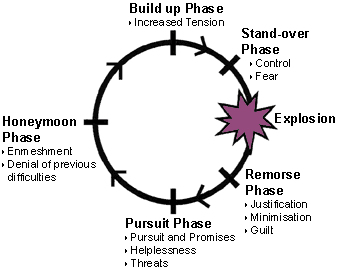 This is the last part of the Cycle of Violence. It is the culmination of the insidious and convincing trick behaviors that have occurred during Explosion, Remorse, Buy Back, Honeymoon, Normal, and Tension Build Up.
This is the last part of the Cycle of Violence. It is the culmination of the insidious and convincing trick behaviors that have occurred during Explosion, Remorse, Buy Back, Honeymoon, Normal, and Tension Build Up.
The tension in the air has become so great that the home is like a powder keg. Every waking minute, the household members live in fear of an explosion. People speak in hushed tones, they become hypervigilant and keep a check on where the perpetrator is, and they wait.
The moment he enters the scene they know there’s going to be trouble. It may be the way he slams his car door, the sound of his walk, or the way he opens the door. The sounds and signs of impending violence are evident and the family tries to make themselves invisible.
The Stand Over phase has been rephrased as, “walking on egg shells” by many women survivors of domestic violence. They report that during this dreadful stage of fear they act as though they are walking on eggshells. They know that they can do nothing right and that they are gong to get into trouble for anything and everything. They walk the house as though hugging the walls, trying to make themselves small and unnoticeable. They keep the peace, they stay out of the way, and they wait for the explosion.
This is such a psychologically uncomfortable stage that many women will subconsciously provoke the explosion. None of us enters relationships to have them fall apart. We all want the safety, love and companionship that marriages are sold as providing. Women stay in domestic violence situations because they too want this. Once the explosion happens, the victims inherently understand that they will get some great times during remorse, buyback and honeymoon.
In the interests of moving the cycle forward to the better times, the victim may do something to speed the process. She may slam his plate down in front of him, speak during a T.V show, or touch him on the arm. He explodes and there is a situation similar to what we had in part 1, The Explosion.
This subconscious process of provocation places women and children at great risk. Far too many domestic violent deaths occur. Far too many neighbors close their ears and eyes to the sounds and signs of violence. Not wanting to get involved, the neighbors find themselves invited into the Cycle of Violence and walking on their own eggshells. They makes themselves invisible and hope that things will quickly settle.
In the first part of this series, we learnt that The Cycle of Violence is a pattern of behavior that occurs in many relationships. Once the pattern has completed one full cycle, it occurs at a faster rate second time round. Subsequent cycles increase in speed until eventually there is insufficient time for the cycle to complete itself. When this occurs, parts of the cycle mutate. The first to change is Remorse. Changing to Minimization (“I didn’t punch you, I only slapped you”), Blame (“If you didn’t smile at the Butcher I wouldn’t have to slap you”) and then Denial (“I didn’t do anything. You can’t prove a thing”), the stage eventually drops out all together. Then Buyback disappears, followed by Honeymoon and Normal. Eventually the relationship operates in the top three parts of the Cycle: Explosion, Tension Build Up and Stand Over.
Although I would never presume to know any person well enough to tell them what I think they should do, when I am faced with a relationship operating in the top three parts of the Cycle of Violence I tell the victim that nobody can guarantee their safety and they may need to leave.
Domestic Violence is an act of abuse. It is against the law and it kills people. The Cycle is a pattern of behavior that can be broken with intensive therapy. Learning new ways of behaving is possible but it takes a long time and a lot of effort. One partner alone cannot change the Cycle if their decision is to stay in the relationship. The perpetrator needs to become responsible for his violence and manage his own behavior. When he seeks professional intervention there is always the chance that the relationship will improve. However, therapeutic change is confronting, frustrating and slow. He has to be serious about lasting the distance and changing his behavior, not just changing it during the stages of Remorse, Buyback and Honeymoon.
Tomorrow we’ll look at how we may inadvertently teach our children the Cycle of Violence, even if there is no overt domestic violence occurring in our relationships. The value of recognizing the Cycle in our socialization of our children is that once we realize what we are doing, we can use a formula of clear communication to break the Cycle and move into different ways of parenting. By teaching our children emotional resilience and clear communication we have a better chance of ensuring our babies do not become trapped in violent relationships later in life.

